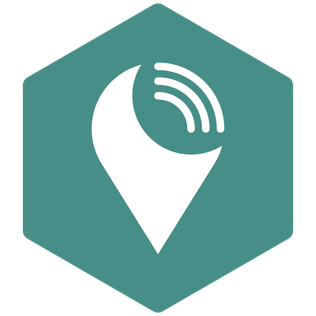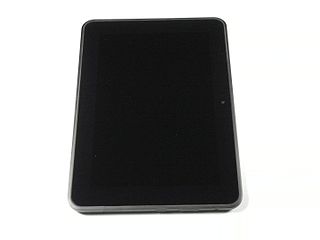
In computing, a device driver is a computer program that operates or controls a particular type of device that is attached to a computer or automaton. A driver provides a software interface to hardware devices, enabling operating systems and other computer programs to access hardware functions without needing to know precise details about the hardware being used.
In telecommunications and computer networks, a channel access method or multiple access method allows more than two terminals connected to the same transmission medium to transmit over it and to share its capacity. Examples of shared physical media are wireless networks, bus networks, ring networks and point-to-point links operating in half-duplex mode.
Ultra-wideband is a radio technology that can use a very low energy level for short-range, high-bandwidth communications over a large portion of the radio spectrum. UWB has traditional applications in non-cooperative radar imaging. Most recent applications target sensor data collection, precise locating, and tracking. UWB support started to appear in high-end smartphones in 2019.

Nordic Semiconductor ASA was founded in 1983 and is a Norwegian fabless technology company with its headquarters in Trondheim, Norway. The company specializes in designing ultra-low-power wireless communication semiconductors and supporting software for engineers developing and manufacturing Internet of Things (IoT) products.
In computing, Microsoft's Windows Vista and Windows Server 2008 introduced in 2007/2008 a new networking stack named Next Generation TCP/IP stack, to improve on the previous stack in several ways. The stack includes native implementation of IPv6, as well as a complete overhaul of IPv4. The new TCP/IP stack uses a new method to store configuration settings that enables more dynamic control and does not require a computer restart after a change in settings. The new stack, implemented as a dual-stack model, depends on a strong host-model and features an infrastructure to enable more modular components that one can dynamically insert and remove.

ANT is a proprietary multicast wireless sensor network technology designed and marketed by ANT Wireless. It provides personal area networks (PANs), primarily for activity trackers. ANT was introduced by Dynastream Innovations in 2003, followed by the low-power standard ANT+ in 2004, before Dynastream was bought by Garmin in 2006.
There are several uses of the 2.4 GHz ISM radio band. Interference may occur between devices operating at 2.4 GHz. This article details the different users of the 2.4 GHz band, how they cause interference to other users and how they are prone to interference from other users.
Bluetooth Low Energy is a wireless personal area network technology designed and marketed by the Bluetooth Special Interest Group aimed at novel applications in the healthcare, fitness, beacons, security, and home entertainment industries. Compared to Classic Bluetooth, Bluetooth Low Energy is intended to provide considerably reduced power consumption and cost while maintaining a similar communication range.

TrackR was a commercial key finder that assisted in the tracking of lost belongings and devices. Trackr was produced by the company Phone Halo and was inspired by the founders' losing their keys on a beach during a surfing trip.
Wi-Fi Direct is a Wi-Fi standard for peer-to-peer wireless connections that allows two devices to establish a direct Wi-Fi connection without an intermediary wireless access point, router, or Internet connection. Wi-Fi Direct is single-hop communication, rather than multi-hop communication like wireless ad hoc networks.

Silicon Laboratories, Inc. is a fabless global technology company that designs and manufactures semiconductors, other silicon devices and software, which it sells to electronics design engineers and manufacturers in Internet of Things (IoT) infrastructure worldwide.
Miracast is a wireless communications standard created by the Wi-Fi Alliance which is designed to transmit video and sound directly from devices to display receivers. It can roughly be described as "HDMI over Wi-Fi", replacing cables in favor of wireless. The protocol is utilised in many devices and is used or branded under various names by different manufacturers, including Smart View and AllShare Cast, SmartShare, screen mirroring, Cast, wireless display and screen casting.

The Fire HD, also known as Kindle Fire HD in the generations prior to 2014, is a member of the Amazon Fire family of tablet computers. Fire HD refers to Amazon Fire family tablets with HD resolution. The many generations Fire HD subfamily includes: 7" and 8.9", 7", 6" and 7", 8" and 10.1", 8", 8" and 10.1", 8", 10.1", 8", 10.1", 8", 10.1" and 11". These devices run the Fire OS operating system.

Ring LLC is a manufacturer of home security and smart home devices owned by Amazon. It manufactures a titular line of smart doorbells, home security cameras, and alarm systems. It also operates Neighbors, a social network that allows users to discuss local safety and security issues, and share footage captured with Ring products. Via Neighbors, Ring may also provide footage and data to law enforcement agencies to assist in investigations.

Amazon Fire TV is a line of digital media players and microconsoles developed by Amazon. The devices are small network appliances that deliver digital audio and video content streamed via the Internet to a connected high-definition television. They also allow users to access local content and to play video games with the included remote control or another game controller, or by using a mobile app remote control on another device.
Amazon Echo, often shortened to Echo, is an American brand of smart speakers developed by Amazon. Echo devices connect to the voice-controlled intelligent personal assistant service Alexa, which will respond when a user says "Alexa". Users may change this wake word to "Amazon", "Echo", "Computer", and other options. The features of the device include voice interaction, music playback, making to-do lists, setting alarms, streaming podcasts, and playing audiobooks, in addition to providing weather, traffic and other real-time information. It can also control several smart devices, acting as a home automation hub.
Amazon Alexa or Alexa is a virtual assistant technology largely based on a Polish speech synthesizer named Ivona, bought by Amazon in 2013. It was first used in the Amazon Echo smart speaker and the Echo Dot, Echo Studio and Amazon Tap speakers developed by Amazon Lab126. It is capable of natural language processing (NLP) for tasks such as voice interaction, music playback, creating to-do lists, setting alarms, streaming podcasts, playing audiobooks, providing weather, traffic, sports, other real-time information and news. Alexa can also control several smart devices as a home automation system. Alexa capabilities may be extended by installing "skills" such as weather programs and audio features. It performs these tasks using automatic speech recognition, NLP, and other forms of weak AI.

LoRa is a physical proprietary radio communication technique. It is based on spread spectrum modulation techniques derived from chirp spread spectrum (CSS) technology. It was developed by Cycleo, a company of Grenoble, France, and patented in 2014. Cycleo was later acquired by Semtech.

LDAC is a proprietary audio coding technology developed by Sony, which allows streaming high-resolution audio over Bluetooth connections at up to 990 kbps at 32 bits/96 kHz. It is used by various products, including headphones, earphones, smartphones, portable media players, active speakers, and home theaters.








